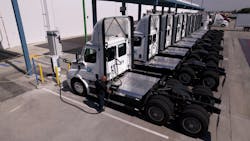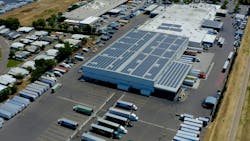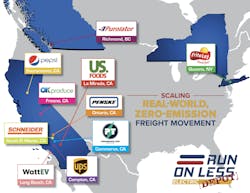Run on Less shows how depots can electrify today
Fleet electrification includes much more than simply purchasing battery-electric vehicles. It includes power infrastructure development, depot management, and much more.
These ancillary challenges to electrification were a focus in the North American Council for Freight Efficiency’s latest demonstration, Run on Less-Electric Depot.
“Where we were seeing concerns from fleets is how to go from having one or two EVs at a fleet depot to having 15 or more,” Denise Rondini, director of communications for NACFE, told FleetOwner. “The thinking behind that is, if you have one or two electric vehicles at your depot, you can probably use existing power to charge those vehicles. But when you start getting upwards of 15, you’re probably going to have to make some infrastructure investments.”
How fleets are growing electric truck operations
Run on Less has published its initial findings from the Run in its 90-page report Electric Truck Depots Are Evolving: How 10 Fleets Grew Their BEV Operations.
Among the report’s key findings is that small fleets are ready to electrify today—but power infrastructure development is still too slow to keep up with larger depots’ power needs.
See also: What are EV truck charging stations’ needs?
Small energy depots, defined as depots requiring less than 10 MWh of power per day, face a lower cost in electrification. With a thin quantity of trucks or low daily distance, small depots can implement slow charging from low-power chargers at a significantly lower TCO.
“People operating in those kinds of duty cycles should feel ready to go with EVs,” Rondini said.
A roadblock to increasing depots’ energy use lies in utilities’ capacity upgrades. For the 10 participating depots, it took between nine and 36 months to energize their infrastructure.
“Probably the biggest challenge that came out of our findings is that it’s still taking too long to get the infrastructure in place,” Rondini told FleetOwner.
To avoid lengthy delays, Rondini said fleets planning to electrify should work with their utilities as early in the process as possible.
Run on Less plans to release more in-depth findings later this year.
Run On Less: Three-week demonstration
What is Run on Less?
Run on Less is a joint effort between NACFE and energy sustainability nonprofit RMI to demonstrate freight efficiency technologies and practices.
Run on Less hosts demonstrations every two years. In 2017, seven fleets participated in real-world demonstrations of diesel fuel efficiency technologies in long-haul applications. In 2019, Run on Less-Regional demonstrated how Class 8 tractors and trailers can achieve greater fuel efficiencies in real-world regional operations.
NACFE focused on real-world EV operations in 2021 with Run on Less-Electric. Finally, in 2023, Run on Less—Electric Depot featured 10 fleet depots and looked at best practices for scaling electric trucks at depots.
NACFE publishes reports and data on each demonstration a few months after the event’s end. Run on Less-Electric Depot finished gathering participating trucks’ data in September 2023 and shared its initial reports in May 2024.
The latest Run on Less demonstration focused on how fleets can grow their BEV populations.
The event took place for three weeks in September, where 10 participating fleets operated a combined 22 vehicles. The vehicles used telematics tracking technology to share operational data, while a variety of fleet personnel participated in 122 interviews.
Before and after the run, NACFE produced various videos, fleet profiles, webinars, workshops, blog posts, and more.
Gathering data
The Run on Less program focuses on gathering real-world data to help fleets better enhance their fuel efficiency.
“One of the things that we pride ourselves on at NACFE is that it represents [the] real world. The trucks in the run deliver freight on their regular schedule,” Rondini said. “The loads are real; the routes are real; the drivers are real. The whole point of this is to show what’s possible in the real world.”
The Run’s 22 vehicles used Geotab devices for telematics data gathering. The devices gathered operational data ranged from speed profiles, regenerative braking energy recovery, and daily range to a vehicle’s number of deliveries and more.
Capturing diverse operations
Run on Less used similar telematics tracking technology across the 22 participating vehicles—but the vehicles and their operations reflected the diversity of U.S. fleets.
The program covered a wide range of equipment types, duty cycles, operating environments, route lengths, driver expertise, and geographic locations. Eight of the participating fleets operated in California, one in New York, and one in British Columbia, Canada.
“We hoped to have a wider geographic split of vehicles,” Rondini said. “That, in part, is a reflection of the reality of the state of the EV market. California’s on the leading edge of this, and so fleets are scaling up a little bit more quickly in California.”
About the Author
Jeremy Wolfe
Editor
Editor Jeremy Wolfe joined the FleetOwner team in February 2024. He graduated from the University of Wisconsin-Stevens Point with majors in English and Philosophy. He previously served as Editor for Endeavor Business Media's Water Group publications.



